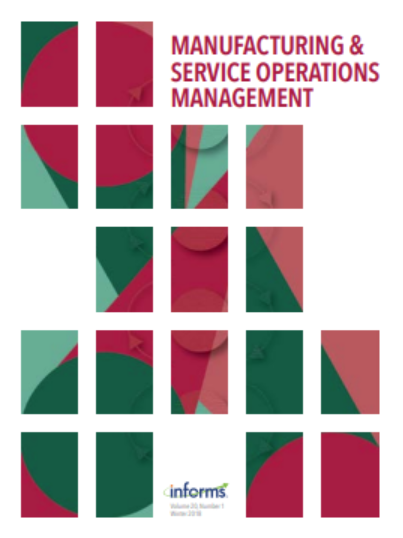共享服务交付可以增加客户参与:共享医疗预约的研究
IF 4.2
3区 管理学
Q1 MANAGEMENT
M&som-Manufacturing & Service Operations Management
Pub Date : 2023-09-29
DOI:10.1287/msom.2021.0012
引用次数: 1
摘要
问题定义:客户和服务提供者通常都认为一对一的服务交付是理想的,假设(也许毫无疑问)投入个性化的关注最能提高客户的结果。相比之下,在共享服务交付中,客户是分批服务的,群体互动的动态可能会增加客户参与度,从而改善结果。然而,失去隐私和人际关系可能会削弱用户粘性。一对一和共享交付模式的参与动态还没有得到严格的研究。在某种程度上,共享交付可能会产生与一对一交付相当或更好的参与,在广泛的环境中,服务提供商可能能够通过批量交付服务为客户创造更多价值。方法/结果:我们对一家大型眼科医院接受青光眼治疗的1000名患者进行了一项随机对照试验,为期三年。使用试验期间录制的超过20,000分钟视频的逐字记录和行为记录,我们研究了分批为患者提供服务的共享医疗预约(sma)如何影响参与度。平均而言,经历过sma的患者每分钟多问33.3%的问题,每分钟多做8.6%的非问题评论。由于SMA中有多名患者,个体患者参与度的增加导致患者在小组环境中听到更多的评论。与参加一对一预约的患者相比,参加sma的患者在一系列广泛的测量中(注意力、积极性、头部摇摆或泰米尔语中的“thalai aattam”:一种表示同意或理解的南印度手势、眼神交流和预约结束时的快乐)也表现出更高水平的非语言参与。管理意义:这些结果揭示了共享服务交付模式的潜力,以增加客户参与度,从而提高服务绩效。本研究得到了伦敦商学院惠勒研究所(WIBAD Ramdas_Sonmez CFP19)、伦敦商学院创业与私人资本研究所(IIE_3432_2019)、Aravind眼科医院和哈佛商学院的支持。补充材料:在线附录可在https://doi.org/10.1287/msom.2021.0012上获得。本文章由计算机程序翻译,如有差异,请以英文原文为准。
Shared Service Delivery Can Increase Client Engagement: A Study of Shared Medical Appointments
Problem definition: Clients and service providers alike often consider one-on-one service delivery to be ideal, assuming, perhaps unquestioningly, that devoting individualized attention best improves client outcomes. In contrast, in shared service delivery, clients are served in batches and the dynamics of group interaction could lead to increased client engagement, which could improve outcomes. However, the loss of privacy and personal connection might undermine engagement. The engagement dynamics in one-on-one and shared delivery models have not been rigorously studied. To the extent that shared delivery may result in comparable or better engagement than one-on-one delivery, service providers in a broad array of contexts may be able to create more value for clients by delivering service in batches. Methodology/results: We conducted a randomized controlled trial with 1,000 patients who were undergoing glaucoma treatment over a three-year period at a large eye hospital. Using verbatim and behavioral transcripts from more than 20,000 minutes of video recorded during our trial, we examine how shared medical appointments (SMAs), in which patients are served in batches, impact engagement. On average, a patient who experienced SMAs asked 33.3% more questions per minute and made 8.6% more nonquestion comments per minute. Because there were multiple patients in an SMA, this increase in engagement at the individual patient level resulted in patients hearing far more comments in the group setting. Patients in SMAs also exhibited higher levels of nonverbal engagement across a wide array of measures (attentiveness, positivity, head wobbling, or “thalai aattam” in Tamil: a South Indian gesture to signal agreement or understanding, eye contact, and end-of-appointment happiness), relative to patients who attended one-on-one appointments. Managerial implications: These results shed light on the potential for shared service delivery models to increase client engagement and thus enhance service performance. Funding: This work was supported by the Wheeler Institute at London Business School (WIBAD Ramdas_Sonmez CFP19), the Institute of Entrepreneurship and Private Capital at London Business School (IIE_3432_2019), Aravind Eye Hospital, and Harvard Business School. Supplemental Material: The online appendix is available at https://doi.org/10.1287/msom.2021.0012 .
求助全文
通过发布文献求助,成功后即可免费获取论文全文。
去求助
来源期刊

M&som-Manufacturing & Service Operations Management
管理科学-运筹学与管理科学
CiteScore
9.30
自引率
12.70%
发文量
184
审稿时长
12 months
期刊介绍:
M&SOM is the INFORMS journal for operations management. The purpose of the journal is to publish high-impact manuscripts that report relevant research on important problems in operations management (OM). The field of OM is the study of the innovative or traditional processes for the design, procurement, production, delivery, and recovery of goods and services. OM research entails the control, planning, design, and improvement of these processes. This research can be prescriptive, descriptive, or predictive; however, the intent of the research is ultimately to develop some form of enduring knowledge that can lead to more efficient or effective processes for the creation and delivery of goods and services.
M&SOM encourages a variety of methodological approaches to OM research; papers may be theoretical or empirical, analytical or computational, and may be based on a range of established research disciplines. M&SOM encourages contributions in OM across the full spectrum of decision making: strategic, tactical, and operational. Furthermore, the journal supports research that examines pertinent issues at the interfaces between OM and other functional areas.
 求助内容:
求助内容: 应助结果提醒方式:
应助结果提醒方式:


